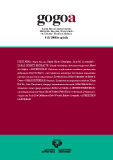Diskurtso erreferituaren erabilera jendaurreko debateetan
##plugins.themes.bootstrap3.article.main##
##plugins.themes.bootstrap3.article.sidebar##
Argitaratua
2011-10-28
Eneritz Garro
Laburpena
Nola aipatu
Garro, E. (2011). Diskurtso erreferituaren erabilera jendaurreko debateetan. Gogoa, 8(1). https://doi.org/10.1387/gogoa.3502
##plugins.themes.bootstrap3.article.details##
Zenbakia
Atala
Artikuluak

